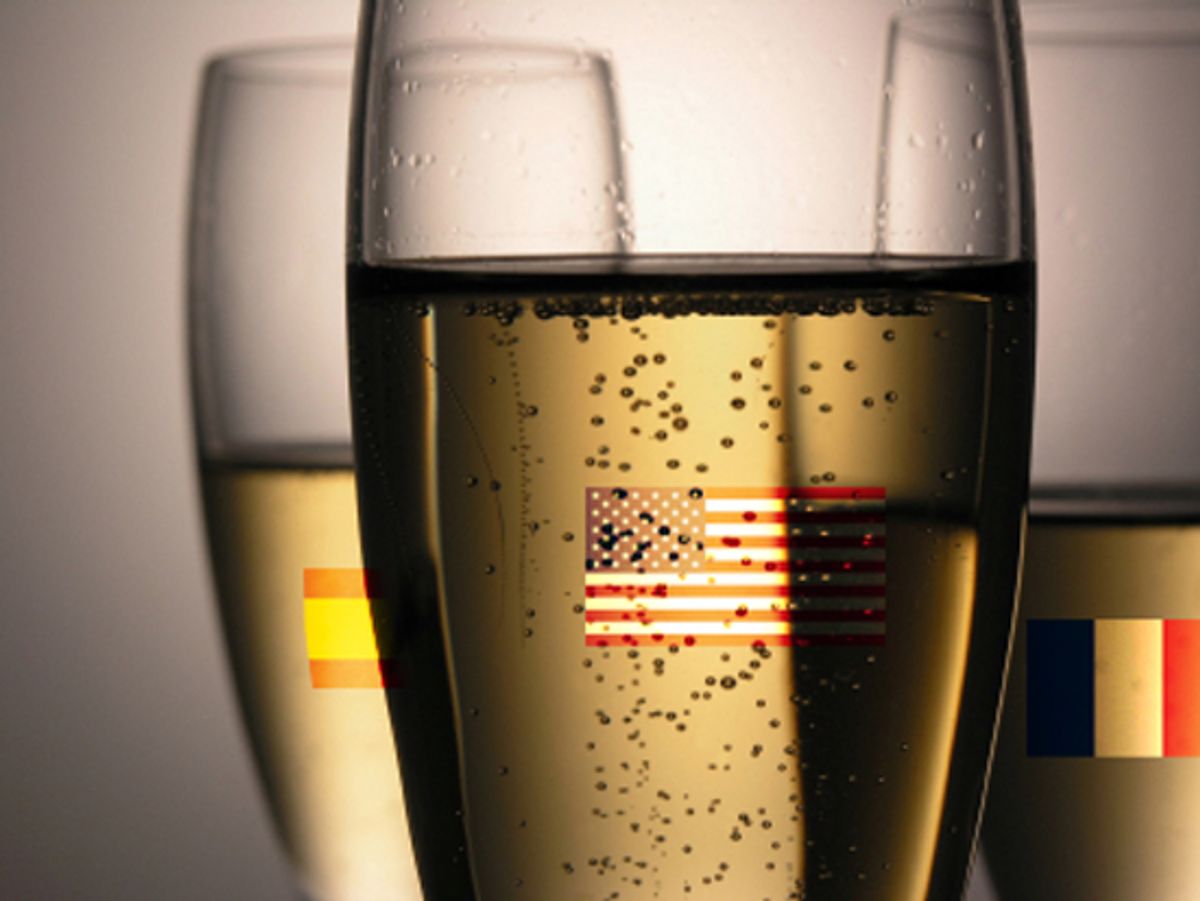We're thrilled to bring you the wine wisdom of Steven Kolpan, the chair of wine studies at the Culinary Institute of America, who will be stopping by regularly with words on what to drink. Today, he'll help you get ready to party on New Year's. What you'll wear is still up to you. (To hear Steven taste and discuss these and other affordable sparklers, go here.)
It's been a year of thrilling highs and long lows, so let's begin 2010 celebrating in classic style. I propose a toast to better days ahead, remembering the words of Napoleon: "In victory, you deserve Champagne, in defeat you need it."
Ah, Champagne! Twenty million bubbles in that bottle, each one contributing to the pleasure of each sip. It's the perfect talisman of celebration, an amulet of joy. Times are harder than usual, but that absolutely doesn't mean we have to give up the bubbly. Affordable alternatives to Champagne abound, and they're great values.
The original Champagne, as in the wine made in Champagne, France, is by law made from only three grapes -- Pinot Noir, Pinot Meunier, and Chardonnay -- and usually from a blend of wines of different vintages, transformed by a near-magical second fermentation in the very bottle that you purchase and pop.
But even without leaving France, we can find fine, affordable sparklers -- either Crémant d'Alsace (look for Lucien Albrecht and Willm, both widely available) or Crémant de Loire (Langlois is the easiest to find). Crémant, available in the dry brut or rosé styles, is an affordable gem at about $15 a bottle and, by law, must be made by the classic méthode champenoise -- the second fermentation, which creates all the bubbles, occurs in the bottle. If you're looking for with a little more sweetness, try Clairette de Die from the Rhône Valley (Jaillance and Raspail are good producers), made primarily from Muscat grapes, and available for less than $20.
Perhaps the world's greatest values in sparkling wines can be found in Spain, and summed up in one word: Cava. These are tasty méthode champenoise sparklers -- mostly brut or rosé -- that start at less than $10. If you want to splurge, you can find artisanal and vintage-dated Cava starting at less than $20. These wines, traditionally made from Macabeo, Parellada, and Xarel-lo grapes, range in style from light and fruity to complex. Just about all of the many Cava producers represented in the American market provide high quality at a great price. Personal favorites: Freixenet Elyssia Gran Cuvée or Brut Nature 2005; Codorníu Selección Raventós; Segura Viudas Reserva Heredad; Gramona Gran Reserva Imperial 2005; Parés Baltà; Aria Estate; Paul Cheneau; Sumarocca; Cristalino Rosé.
If you enjoy your bubbles fresh, bright, light and fruity, with a dry to off-dry finish on the palate, then you will love true Prosecco from Veneto, Italy. (There's a lot of pretend Prosecco out there, like Paris Hilton's Rich "Prosecco," sold in cans and made by an Austrian company whose ads feature the naked, gold-painted heiress. Look for the real thing, which will be labeled "Prosecco di Valdobiaddene.") Prosecco is so much fun in its seductive simplicity, it's almost too drinkable. Right now I'm in love with the Bortolomiol "Prior" Brut, but can also recommend the ubiquitous Mionetto, Bellenda, Bellussi, Nino Franco, Maschio, Zardetto, and Zefiro, among many others. Plan to part with $10 to $17 per bottle for Prosecco; it's money well spent in the pursuit of pleasure.
When it comes to wine, Americans are patriotic – we drink about 70 percent American wine, the overwhelming portion of that from California (about 90 percent). But these statistics don't hold true for bubbly. We tend to like our sparklers to be French, or at least Old World, but we make great sparklers from our home soils, especially those produced by the méthode champenoise. I would happily sip a flute of the following, while toasting better days to come: Iron Horse (always vintage dated, always estate bottled, always a little more expensive -- about $25 to $30 -- and worth it), and bargains from the great Roederer Estate, as well as Scharffenberger, Gloria Ferrer, Domaine Carneros, and Domaine Chandon, all from California, and all $15 to $20. From Washington state: Domaine Ste. Michelle Blanc de Blancs (under $15); from Oregon: Argyle Brut 2006 (about $25); from New York: Chateau Frank Blanc de Blancs 2002 (about $30); and my perennial favorite from New Mexico: Gruet Blanc de Noirs (about $16).
Whether we opt for true Champagne or great sparkling wine from any other part of the world, may we all have a wonderful and peaceful New Year. And remember, affordable sparklers are not just for holidays. An inexpensive bottle of bubbly can turn the simplest meal into a celebration. Perhaps Lily Bollinger, of the eponymous Champagne house, said it best when speaking about her favorite sparkling wine:
"I only drink Champagne when I'm happy, and when I'm sad. Sometimes I drink it when I'm alone. When I have company, I consider it obligatory. I trifle with it if I am not hungry and drink it when I am. Otherwise I never touch it -- unless I'm thirsty."



Shares